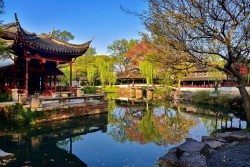You have no items in your shopping cart.


Introducing Suzhou Museum
Founded in 1960 and originally located in the national historic landmark, Zhong Wang Fu palace complex, Suzhou Museum has been a highly-regarded regional museum with a number of significant Chinese cultural relics. Suzhou Museum was designed by Pritzker Prize-winning Chinese-American architect Mr. Ieoh Ming Pei, a Suzhou native. Suzhou Museum is said to be the last design of Mr. Ieoh Ming Pei in his career. Therefore, not only does it become a monumental design building, but also one of the most iconic buildings in Suzhou, merging the traditional Chinese architectural design with the future.
Suzhou Museum Fast Facts
• Chinese Name: Suzhou Bowuguan 苏州博物馆
• Best Time to Visit: All year around
• Recommended Visiting Hours: About 1 to 2 hours
• Things to Do: Photography, Architecture, History and Culture
• Opening Hours: Tuesday to Sunday, 09:00-17:00
• Entrance Fee: Free
• Address: No. 204, Dongbei Street, Gusu District, Suzhou, Jiangsu Province
What to expect at Suzhou Museum
Suzhou Museum was completed in October 2006, covering over10,700 square meter and located at the cross of Dongbei Street and Qimen Road. The design of Suzhou Museum visually complements the traditional architecture of Zhong Wang Fu. Suzhou Museum houses over 30,000 cultural relics --- most notably for excavated artifacts, Ming and Qing Dynasty paintings and calligraphy, and ancient arts and crafts. The basic exhibitions include: Wu Pagodas, Wu Treasures, Wu Paintings and Calligraphy.
Wu Pagodas
Acting as the center of Wu Region (12 Century-473 BC), Suzhou has been shining like a resplendent pearl inlaid into the vast land on the south bank of Yangtze River. 10,000 years ago, human footprints in Sanshan Island (50 kilometers from Suzhou) kicked off local history of mankind. 2,500 years ago, establishment as capital of Wu State (514 BC) set off in the pursuit of urban civilization of Suzhou.
Wu Treasures
“National Treasures in Famous Wu Pagodas” prominently exhibit Buddhism relics found in Yunyan Temple Pagoda on top of Tiger Hill and Ruiguang Temple Pagoda near Panmen Gate, both regarded as symbols of Suzhou. These relics are exhibited in two sections facing each other on south and north.
Wu Paintings and Calligraphy
In Ming Dynasty, over 150 famous painters lived in Suzhou. They formed a well-known Wu School in history. in the mid-Ming Dynasty. Shen Zhou, Wen Zhengming, Tang Yin and Qiu Ying with their original painting style and excellent art achievement, earned the great reputation in the painting circle. They are called Four Masters of Wu School in the painting history.
How to get to Suzhou Museum
• Take bus No. 178, 202, 125 309, 529, 811, 925, Tourist Line 1 Line 2, or Line 5 and get off at Suzhou Museum Station.
Additional travel advice on Suzhou Museum
• The museum is closed on Mondays except Chinese public holidays.
• To protect relics, please do not use the camera flash while photographing.
• Food and colored drinks are not allowed to bring into the museum.